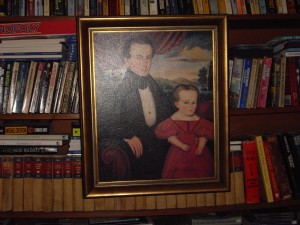In my little library hangs a portrait from about the year 1840 of a man and his child. That child is the man’s son, which surprises many viewers, who are thrown off track by the fact that the little boy is wearing what appears to be a dress. This, however, was the custom through the 18th Century and 19th Century, so that boys wore such clothing until approaching puberty. I suppose male clothing was a symbol of reaching a certain stage of maturity. In any event, I’ve had the picture about forty years, and it has become a familiar part of my home.
The subjects in the portrait were painted in almost a primitive style, even though the painting suggests that the father is a man of means. The swirl of drapery, the expensive sofa, the quality of clothing all suggest that he was perhaps a landowner, banker, or municipal figure of some high station. The gaze of the subjects is unchanging and, in some strange way for me, comforting in the sense that they have been there for almost as long as I can remember. They were there the night my father died, and again when my brother, sister, and mother died, all at different times over the span of twenty-five years. Each time the subjects in that picture looked out at me as though they understood grief and were sympathetic to the terrible feeling of loss. They were there on birthdays, Christmas mornings,on my returns home from travel, always telling me that life was good and that there was something enduring.
There is another painting, an oil done in London, also in 1840 (artist unknown), of an elderly woman wearing a soft wool shawl. The wisdom and kindness in her face have been a comforting presence also over more years of my life than I care to count. In times of celebration and also mourning, she has looked out at me with a gaze of understanding and compassion that has probably not really changed in the human face for thousands of years. My partner Jim calls her and other old portraits that hang in the library and staircase “the gallery of dead people,” but my affection for those pictures is unwavering.
There is over my desk a photograph taken by Jim at the Art Institute of Chicago in May of 2007, when we both spent the day looking at wonderful collections throughout the museum. Though neither of us can remember the artist or the actual title of this picture, we call her Minnie, and she continues to energize the hallway, making guests to our home smile at her outrageous level of joy. Everyone who looks at Minnie lights up at the surprise and power of her “joie de vivre.”
Both paintings and the photograph are reminders to me that we are all connected as a human family, all of us through however long we as a species have been in this world. JB



